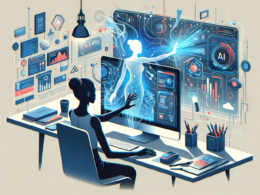As the tech world eagerly anticipates a future dominated by artificial intelligence, there remains a somewhat neglected issue that continues to frustrate users: inconsistent and often inadequate multi-monitor support. Despite numerous advancements in AI and other high-tech fields, the seemingly simple task of effectively managing multiple display setups remains a hurdle for many users, particularly those with unique configurations.
Zooming In
The State of Multi-Monitor Support
The reliance on multiple monitors has become commonplace in many industries, from gaming to finance. A survey by the Jon Peddie Research firm shows productivity can increase by 42% with the use of two or more monitors. Yet, usability issues persist, showing a gap between high-tech functionalities like AI and everyday user demands. Inefficiencies in managing multi-monitor setups have been a longstanding frustration, with issues such as persistent phantom desktops and disorganized display orders plaguing users. This has been especially problematic for those who switch between different display technologies, such as OLEDs for high-quality gaming and CRTs for vintage entertainment.
Recent Developments
In recent months, there have been notable developments in the tech sector that underscore the maturity and complexity of AI applications. Major companies like Microsoft have rolled out advanced AI solutions such as Microsoft’s Copilot, an AI assistant designed to enhance productivity. Meanwhile, hardware manufacturers like AMD are embedding AI processors in their products to optimize performance. Nevertheless, these advances might seem hollow if foundational user interface elements such as multi-monitor support continue to falter.
The Impact on Users
For tech enthusiasts and professionals alike, the inefficiencies in managing multi-monitor setups can impede workflow and productivity. Users are often forced to navigate a myriad of shortcuts and manual adjustments to keep their displays functioning as desired. Furthermore, updates in hardware, such as a graphics card upgrade, often disrupt existing setups, demanding additional time to restore normalcy.
A Call for Improved User Experience
Industry experts advocate for more robust solutions, emphasizing that a company making strides in AI should be equally committed to refining user interface capabilities. Multi-monitor support should be intuitive and adaptable to diverse setups, seamlessly integrating with a range of display types and configurations. Experts suggest that integrating AI into these solutions could potentially enhance automatic detection and configuration of monitors, ensuring smoother transitions between display modes.
The Path Forward
While AI captures imaginations, the road to a utopian tech future must also consider the foundational aspects of user experience. As we advance, it is crucial for tech giants to recognize the importance of everyday functionalities such as multi-monitor support, providing seamless operations that match the sophistication of AI technologies. Moving forward, integrating AI solutions into day-to-day utilities could revolutionize not just our perception of technology, but our interaction with it as well.
The balance between innovation in AI and improvements in user interface seems essential. As consumers appreciate cutting-edge advancements, satisfaction truly lies in the seamless integration of these technologies into their daily lives. Addressing these grievances will not only improve user satisfaction but also sustain the momentum of growth in this rapidly evolving digital landscape.









